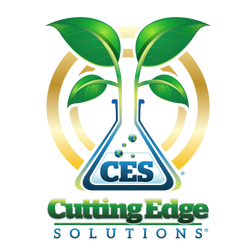Is Your pH Up Clogging Your Irrigation System?
If your fertigation lines are slowing down or emitters are plugging up, you might suspect hard water or nutrient residue. But there’s another, less obvious culprit that many growers overlook: your pH Up product.
While pH adjusters are a necessary part of every nutrient regimen, the type of chemical used in your pH Up can make a huge difference in system performance. Some pH adjusters do their job effectively — but also trigger unwanted reactions that lead to clogging, reduced nutrient flow, and long-term buildup in your irrigation system.
Let’s break down what’s happening and how you can prevent it.

The Hidden Chemistry Behind Clogged Lines
Many commercial and hobby growers use Potassium Hydroxide (KOH) as their go-to ingredient for raising pH. It’s a strong base that quickly increases alkalinity, but its reactivity can become a major issue when mixed into solutions containing calcium (Ca).
Here’s the chemistry at work:
When KOH is introduced into a nutrient solution containing calcium ions (Ca²⁺) — which are present in most base nutrients and hard water — the hydroxide ions from KOH react with the calcium ions to form Calcium Hydroxide (Ca(OH)₂), an insoluble solid compound.
This reaction looks simple on paper:
Ca²⁺ (aq) + 2 OH⁻ (aq) → Ca(OH)₂ (s)
But the “(s)” — meaning solid — is exactly what you don’t want. These microscopic calcium hydroxide crystals don’t dissolve back into solution. Instead, they float as a milky white cloud before settling and building up inside emitters, drip lines, and filters. Over time, this accumulation can constrict water flow, create uneven nutrient delivery, and even lead to full system blockages.
The result: more maintenance, less efficiency, and unpredictable feed consistency for your crop.

What You’ll See in Your System
You don’t need a microscope to know when calcium hydroxide buildup is happening — there are clear warning signs every grower can watch for.
1. Cloudiness or white precipitate:
Right after adding your pH Up, you might notice a cloudy or milky appearance in your reservoir. This is an early indicator that calcium hydroxide is forming. As the reaction continues, these solids can accumulate and settle, coating the inside of tubing and emitters.
2. Clogged irrigation components:
Over time, the solid buildup restricts water flow and can lead to uneven nutrient distribution. Plants at the ends of irrigation lines might receive less solution or none at all. Even micro-adjustments in pressure won’t fix it — because the clogging is chemical, not mechanical.
3. Persistently high pH:
Since KOH remains strongly alkaline, even after reacting, your solution’s pH can stay elevated longer than expected. This may cause nutrient lockout or imbalances, particularly with micronutrients like iron and manganese that become less available in high-pH conditions.
Ignoring these signs can compromise both equipment lifespan and crop health. What starts as a bit of cloudiness can eventually lead to blocked lines, pH instability, and yield loss.
The Cutting Edge Solution
At Cutting Edge Solutions®, we understand that growers need products that work with their system chemistry, not against it. That’s why our pH Up formulas are intentionally crafted without Potassium Hydroxide (KOH).
Instead, our blends use a combination of Potassium Carbonate (K₂CO₃) and Potassium Silicate (K₂SiO₃) — two safer, more stable bases that effectively raise pH while avoiding calcium precipitation.
Here’s why that matters:
-
Potassium Carbonate adjusts pH gradually, offering stability and control. It increases alkalinity without producing hydroxide ions that cause calcium fallout.
-
Potassium Silicate not only buffers pH but also strengthens plant cell walls, improving structural integrity and stress resistance.
Together, they deliver reliable pH control with added plant health benefits — all without the risk of clogging your fertigation system.
By switching to a KOH-free pH Up, you’ll protect your irrigation infrastructure, maintain consistent nutrient delivery, and minimize downtime spent cleaning emitters and lines.
Clean Chemistry for Reliable Growth
Your nutrient system is the lifeline of your crop. Each element, from your base nutrients to your pH adjusters, should support both plant health and equipment performance.
When pH Up products containing Potassium Hydroxide react with calcium, they create unnecessary complications — clogging lines, wasting nutrients, and increasing labor costs. The chemistry is simple, but the impact can be significant over time.
Choosing Cutting Edge Solutions® pH Up means choosing:
-
A clog-free fertigation system — no more calcium hydroxide buildup.
-
Stable pH control that supports consistent nutrient availability.
-
Enhanced plant resilience, thanks to the inclusion of beneficial potassium silicate.
-
Peace of mind, knowing your nutrients and irrigation are working in harmony.
At Cutting Edge Solutions®, our goal is to engineer nutrient products that integrate seamlessly into any cultivation environment — from boutique indoor grows to commercial greenhouses using automated fertigation.
If you’ve been battling mysterious clogs or white residue in your system, your pH Up could be the hidden cause. Make the switch to a cleaner, smarter solution — and experience the Cutting Edge difference for yourself.
Final Thoughts
Calcium hydroxide precipitation may sound like a small chemical detail, but it has major consequences for growers who rely on precision irrigation. By understanding the science behind your pH adjusters and choosing formulations that prevent unwanted reactions, you can protect your system, your crops, and your bottom line.
Clear systems. Clear results. That’s the Cutting Edge way.

pH Up SP™


